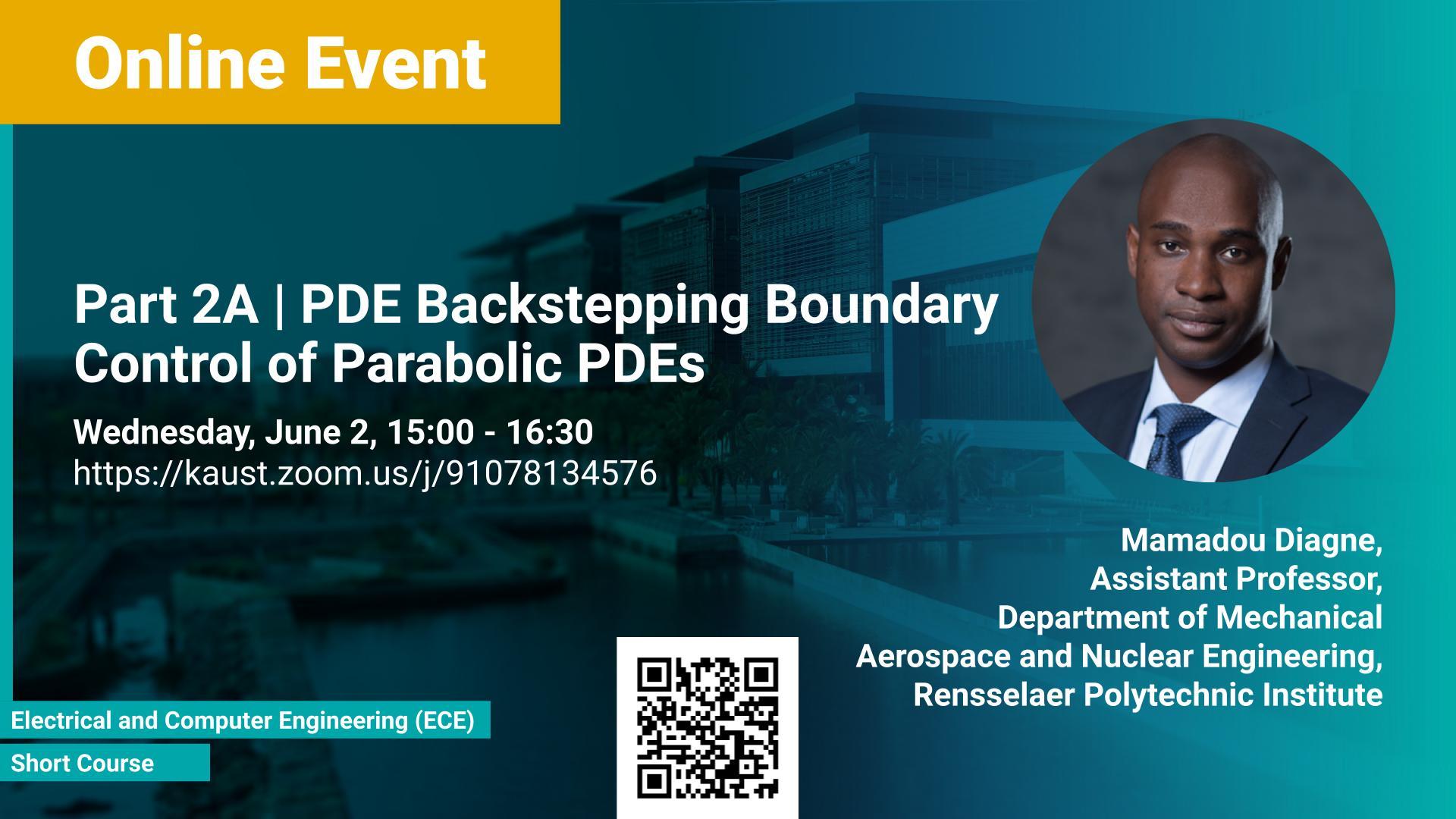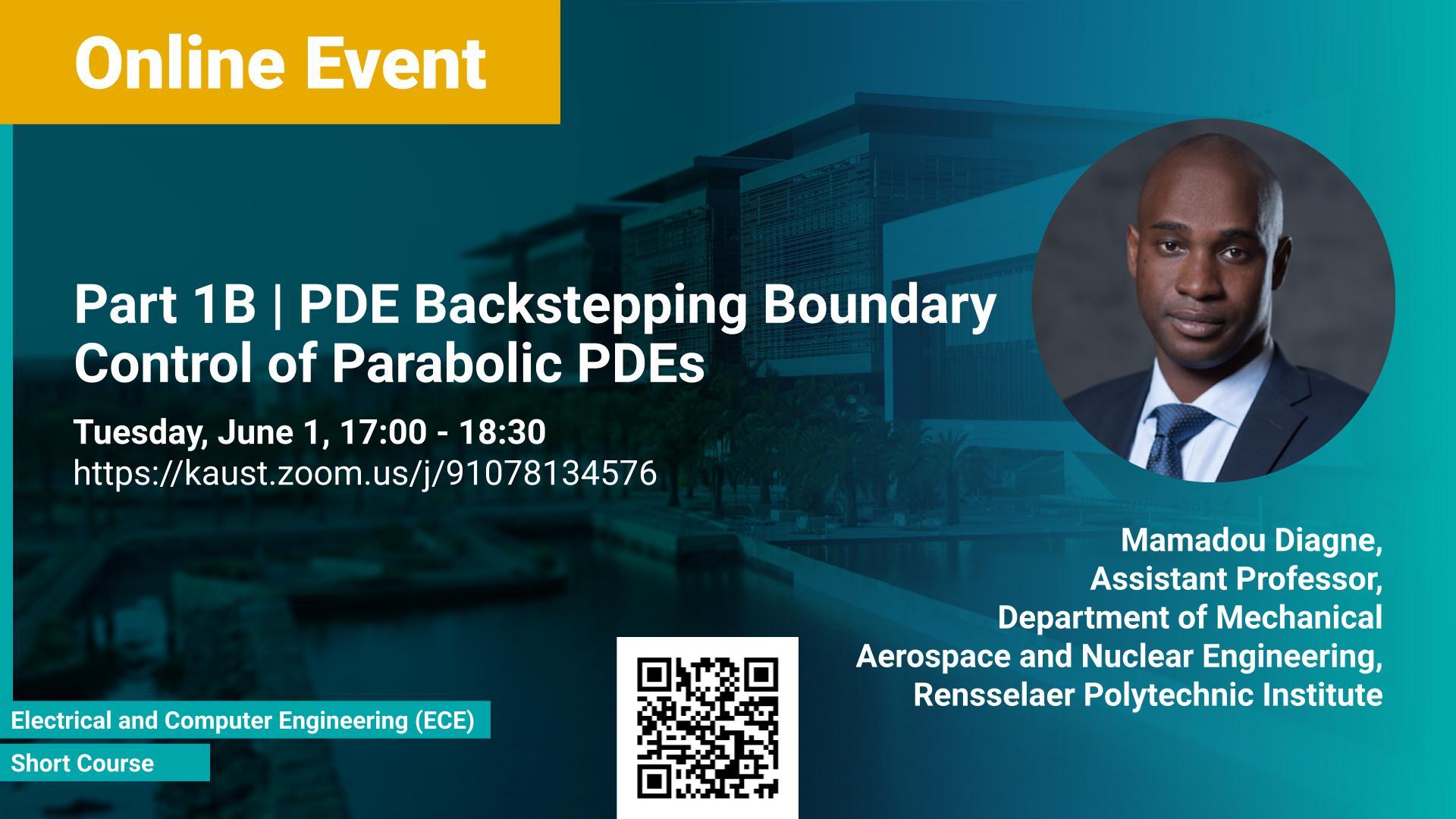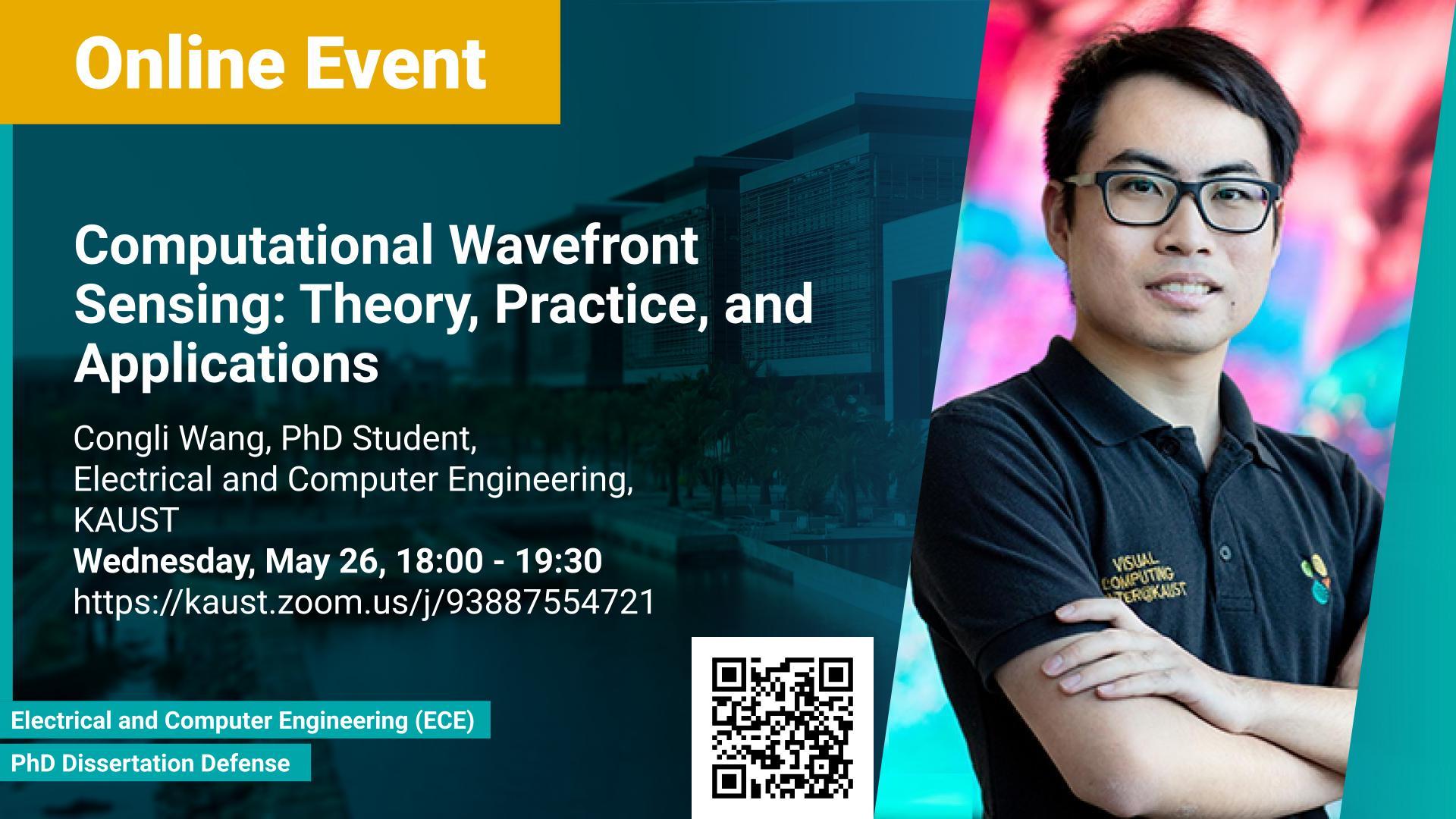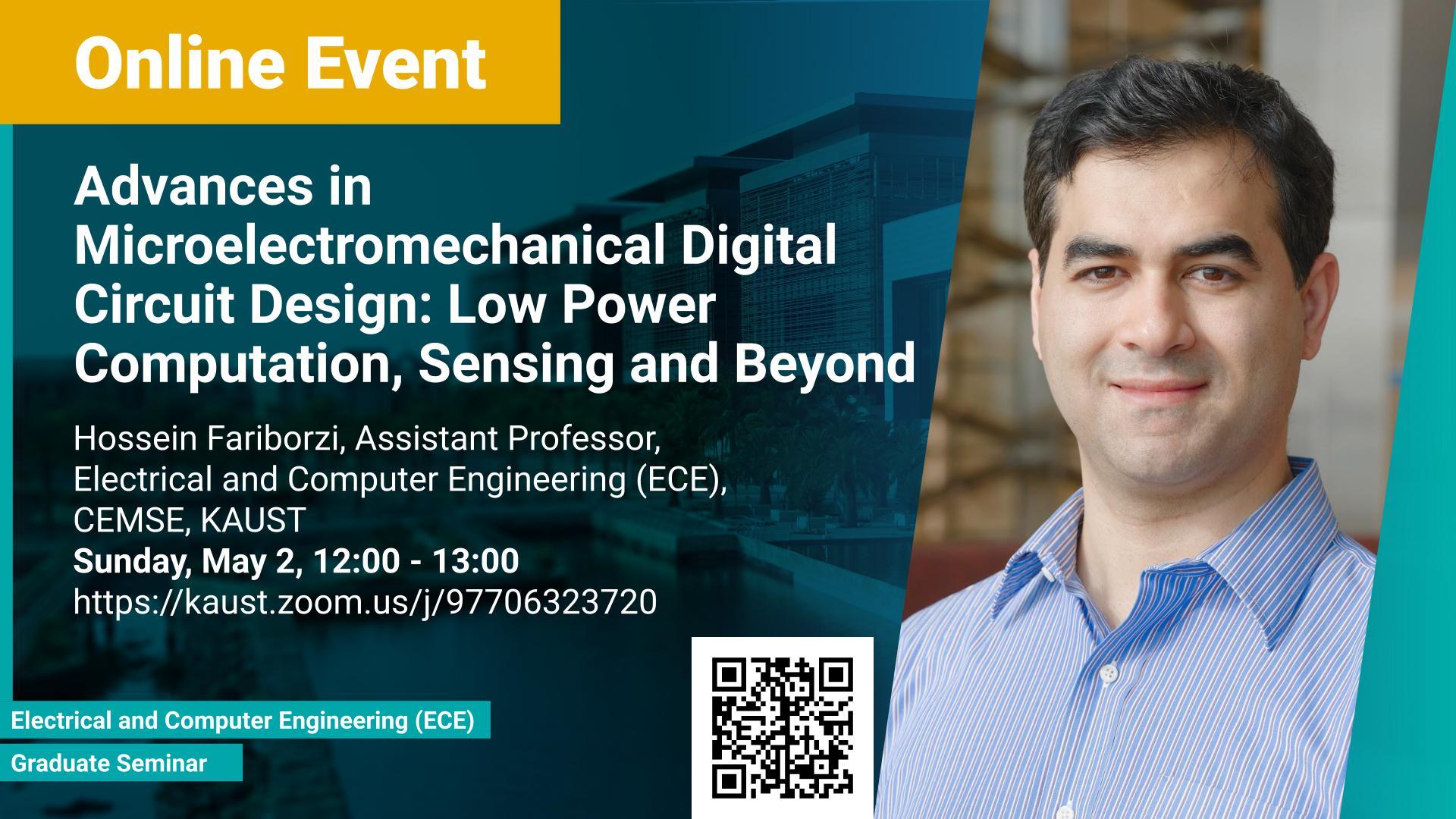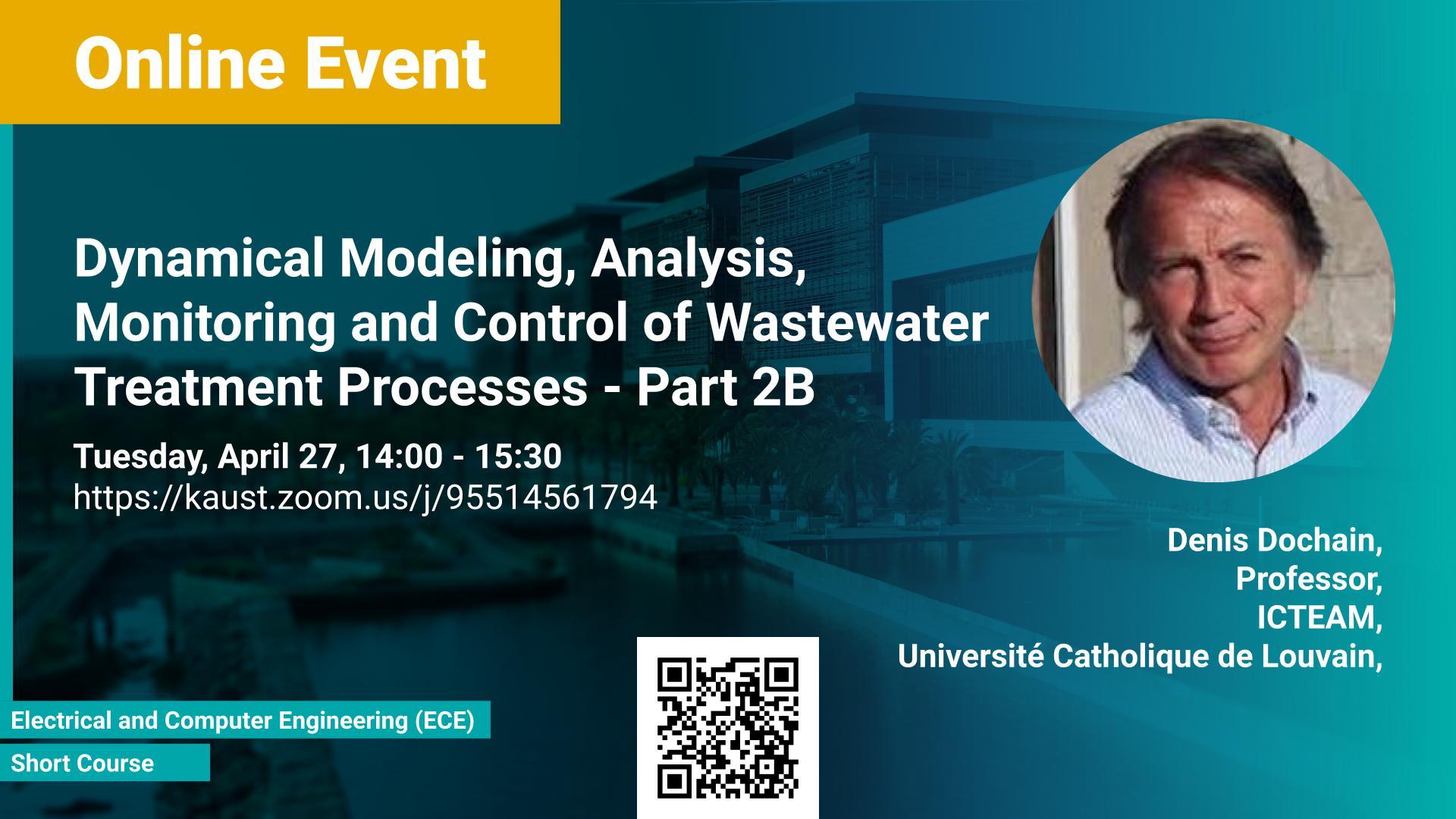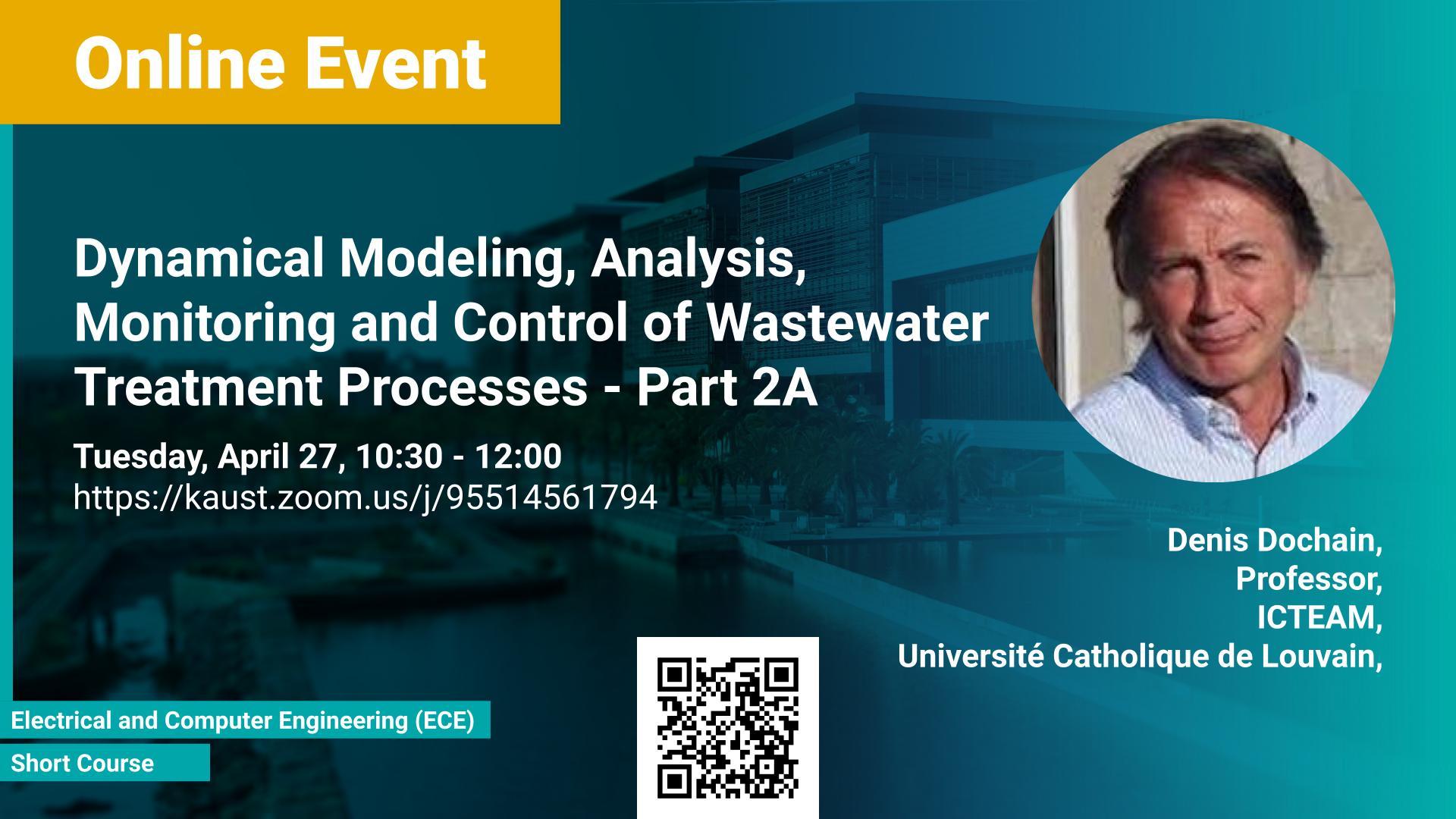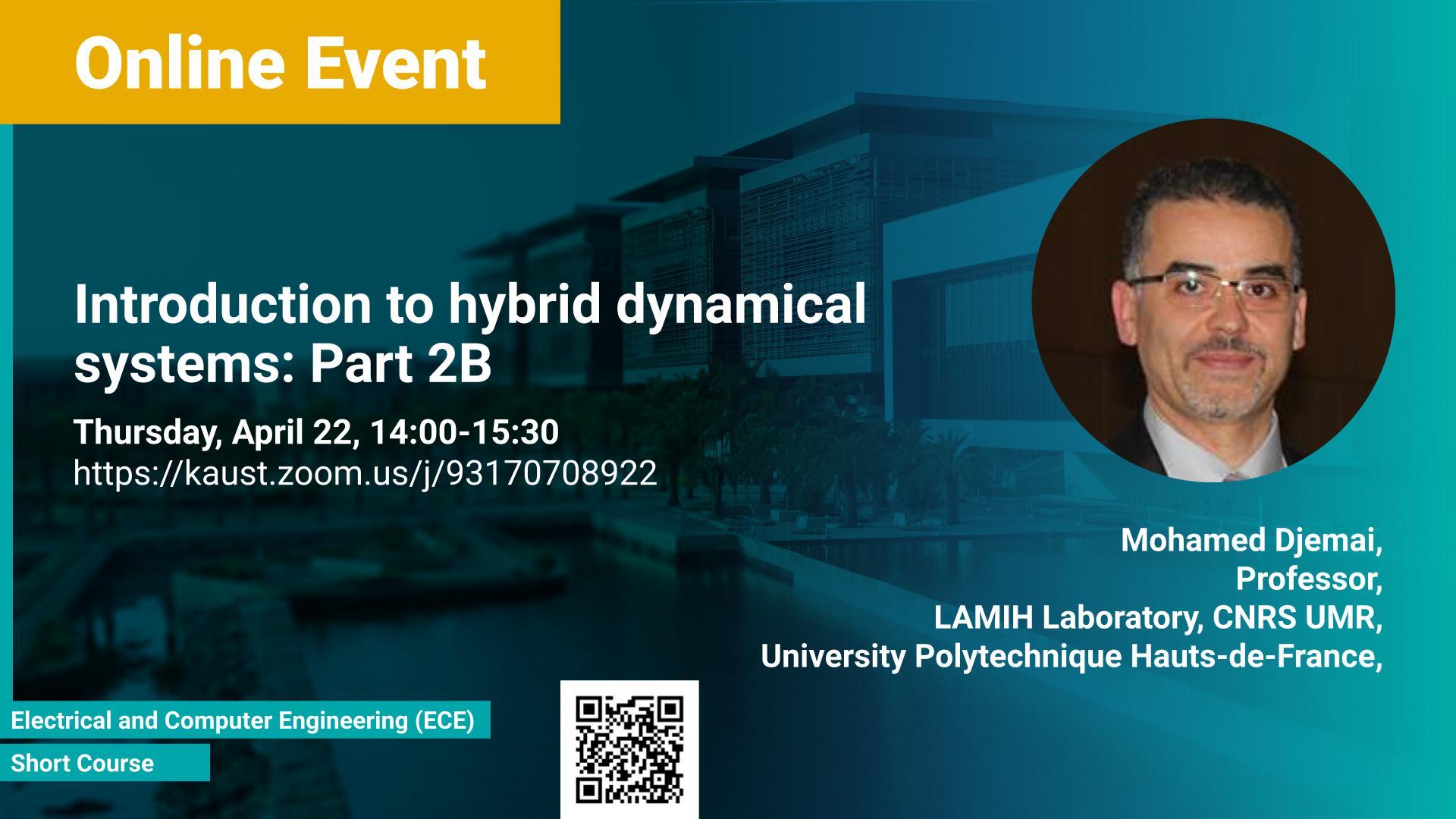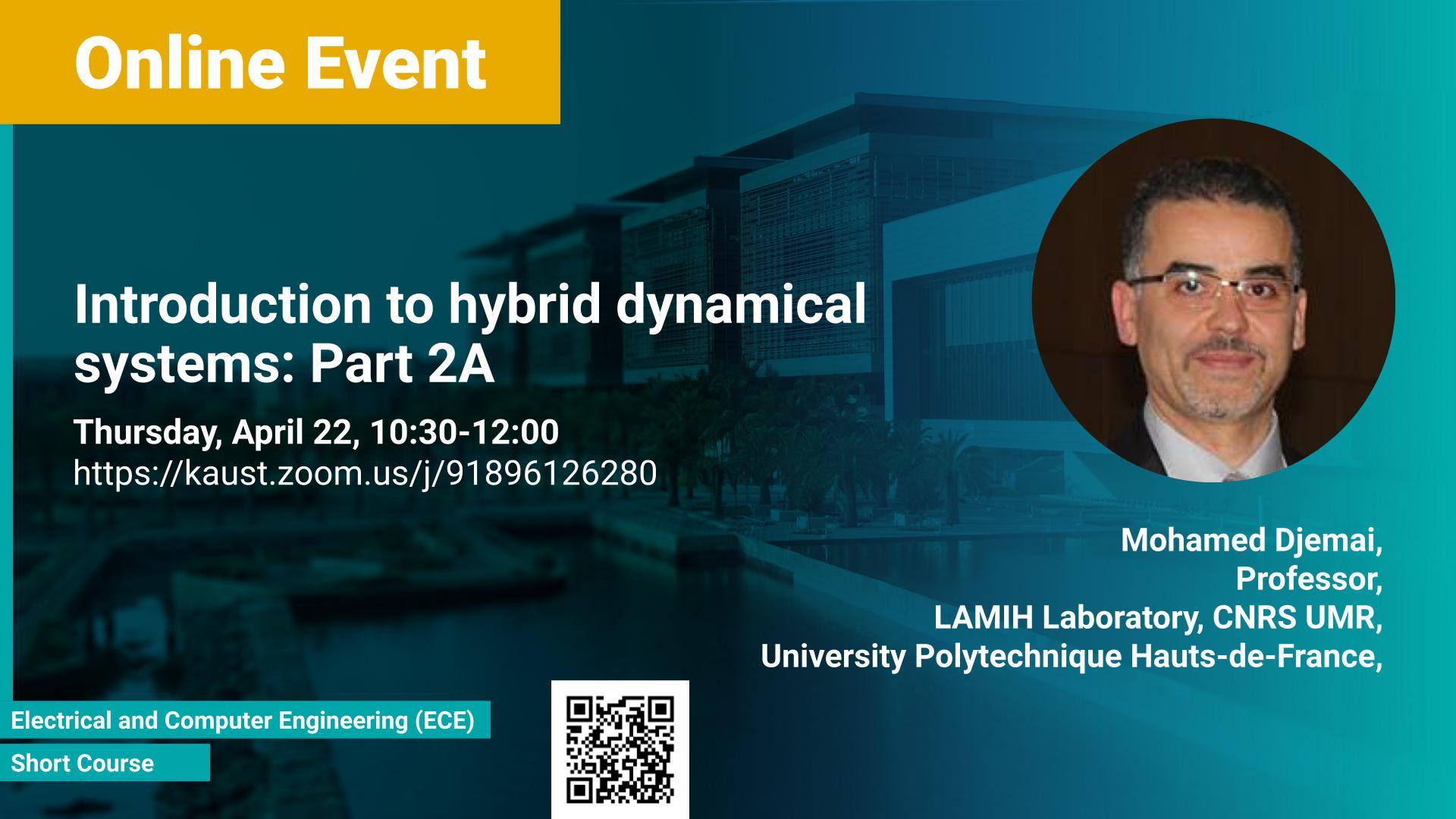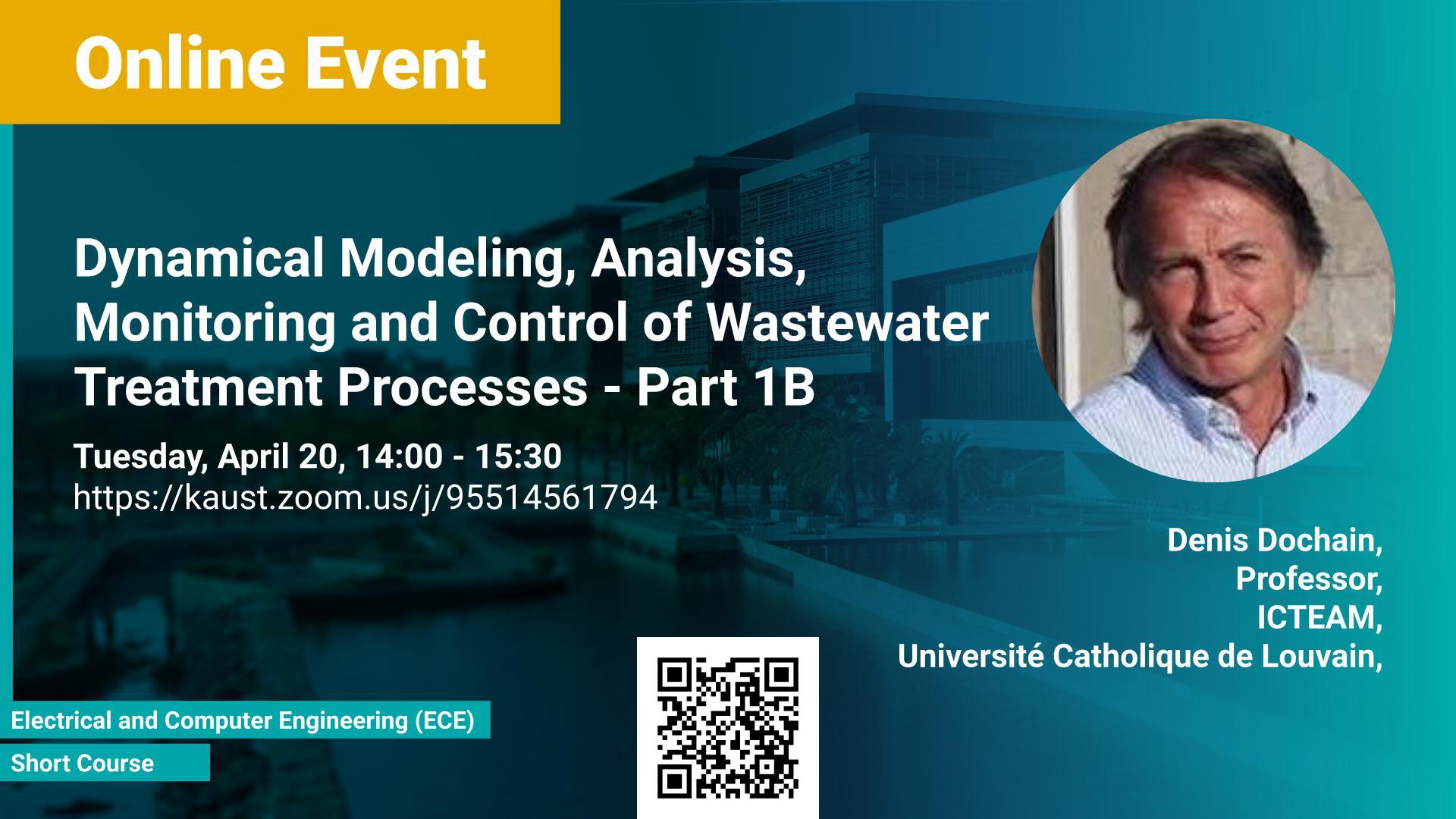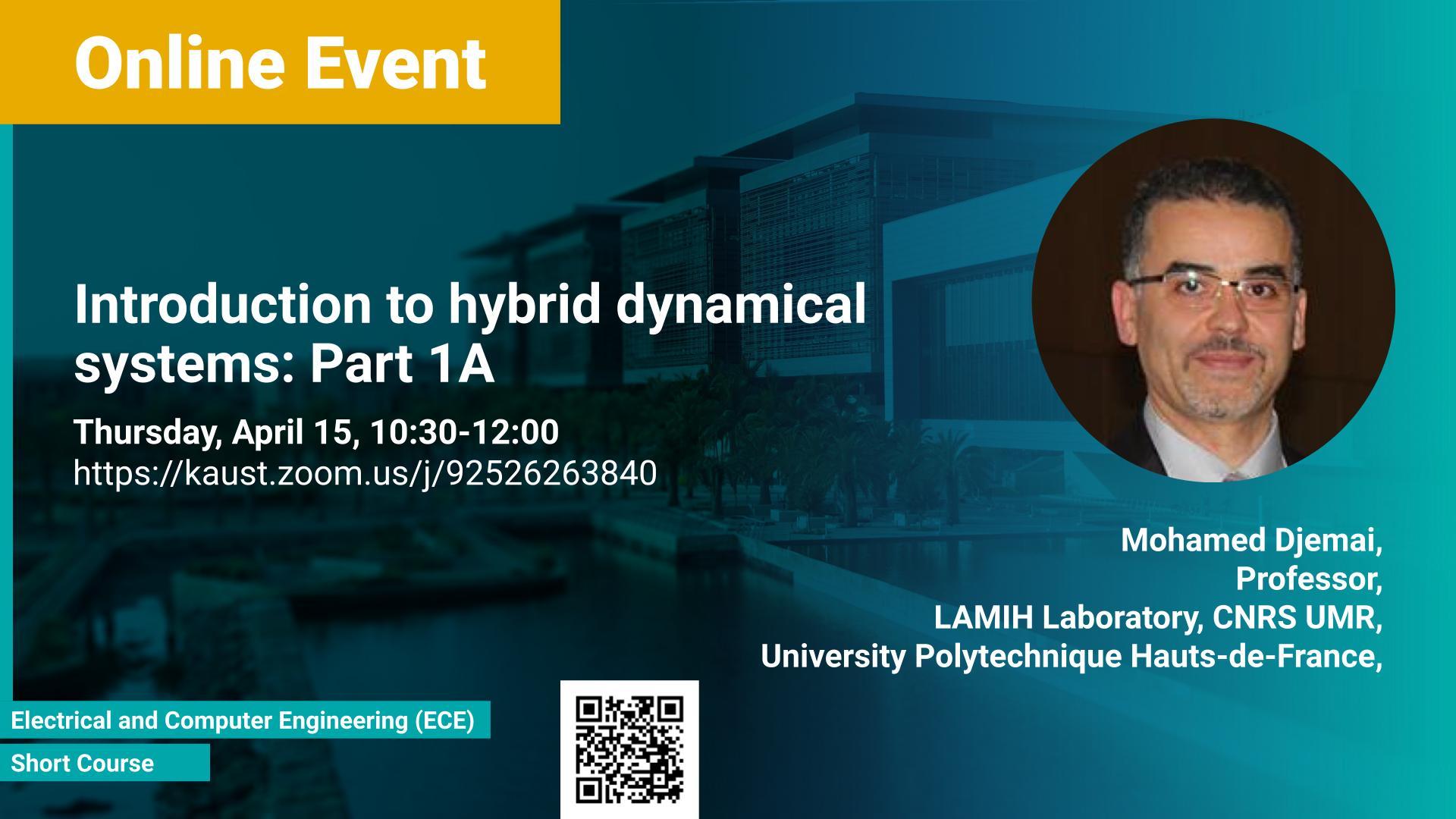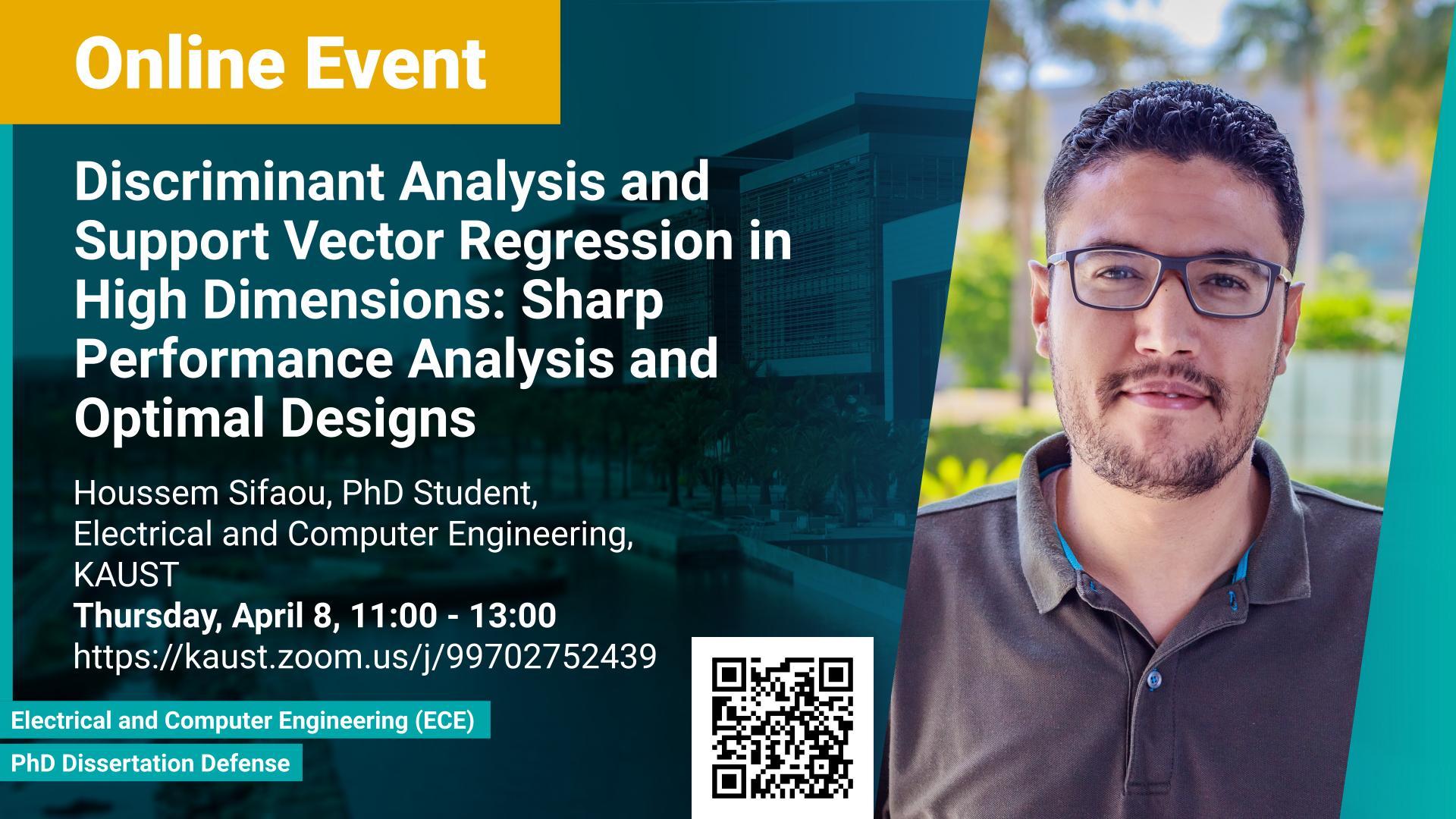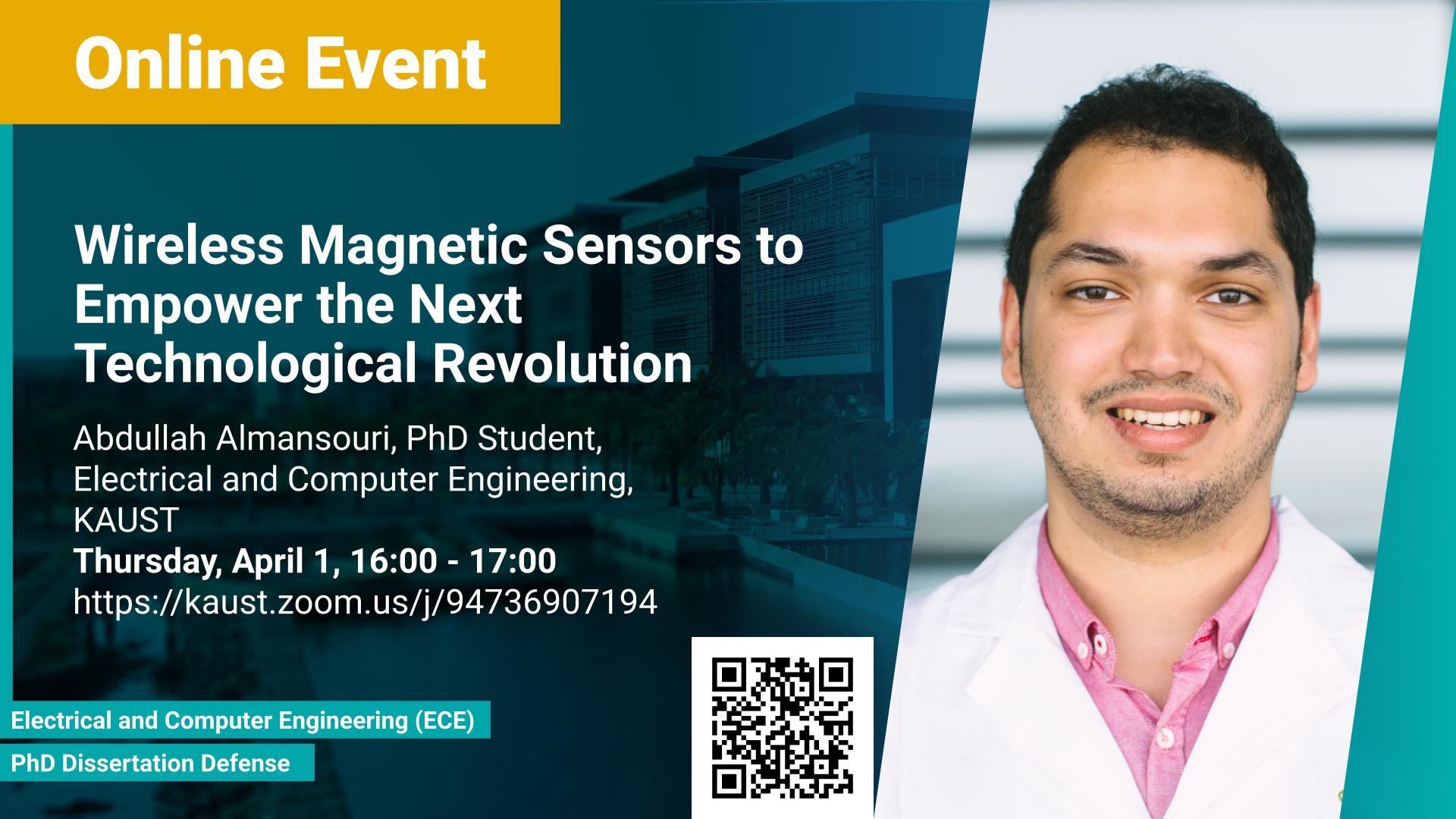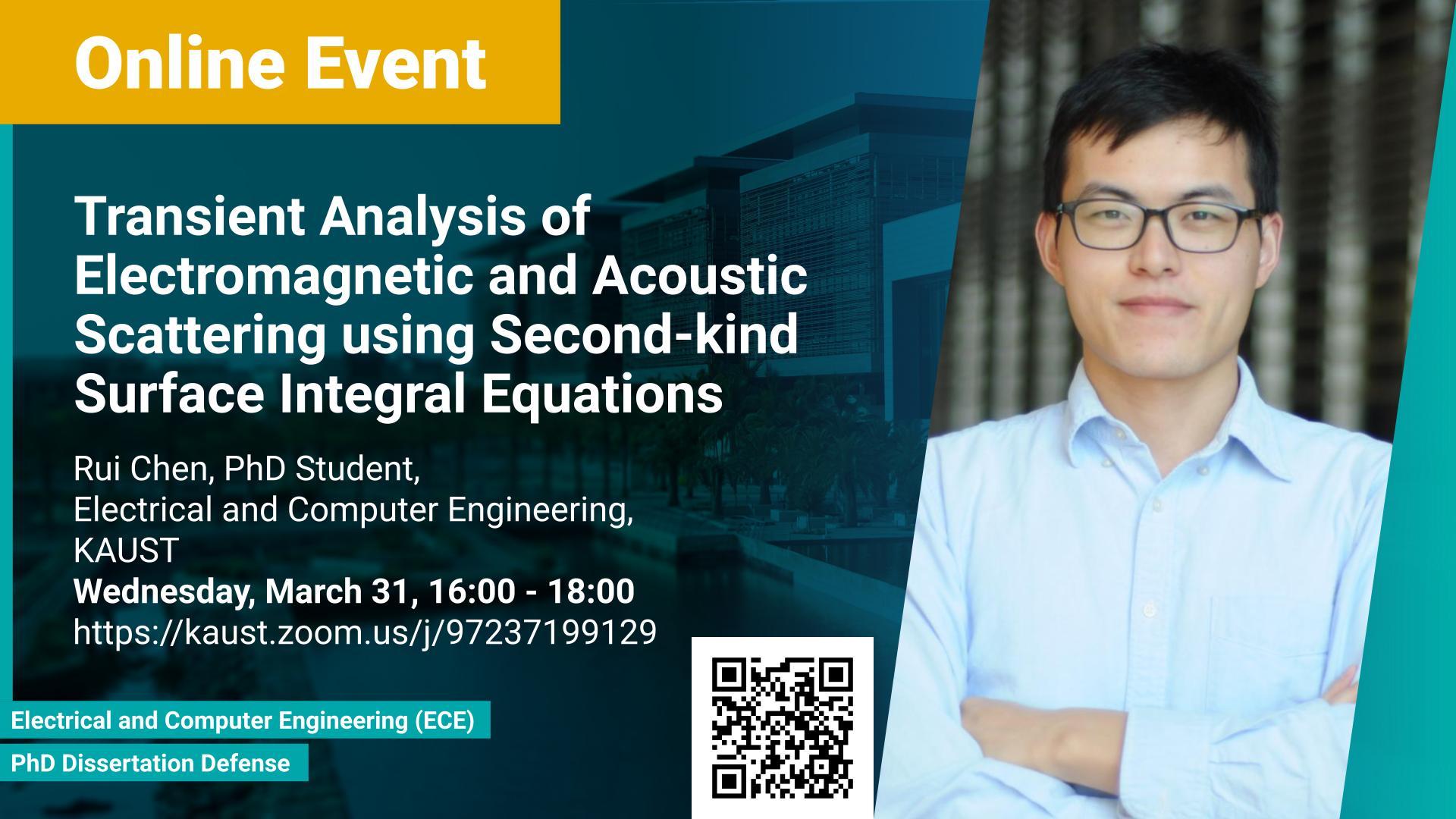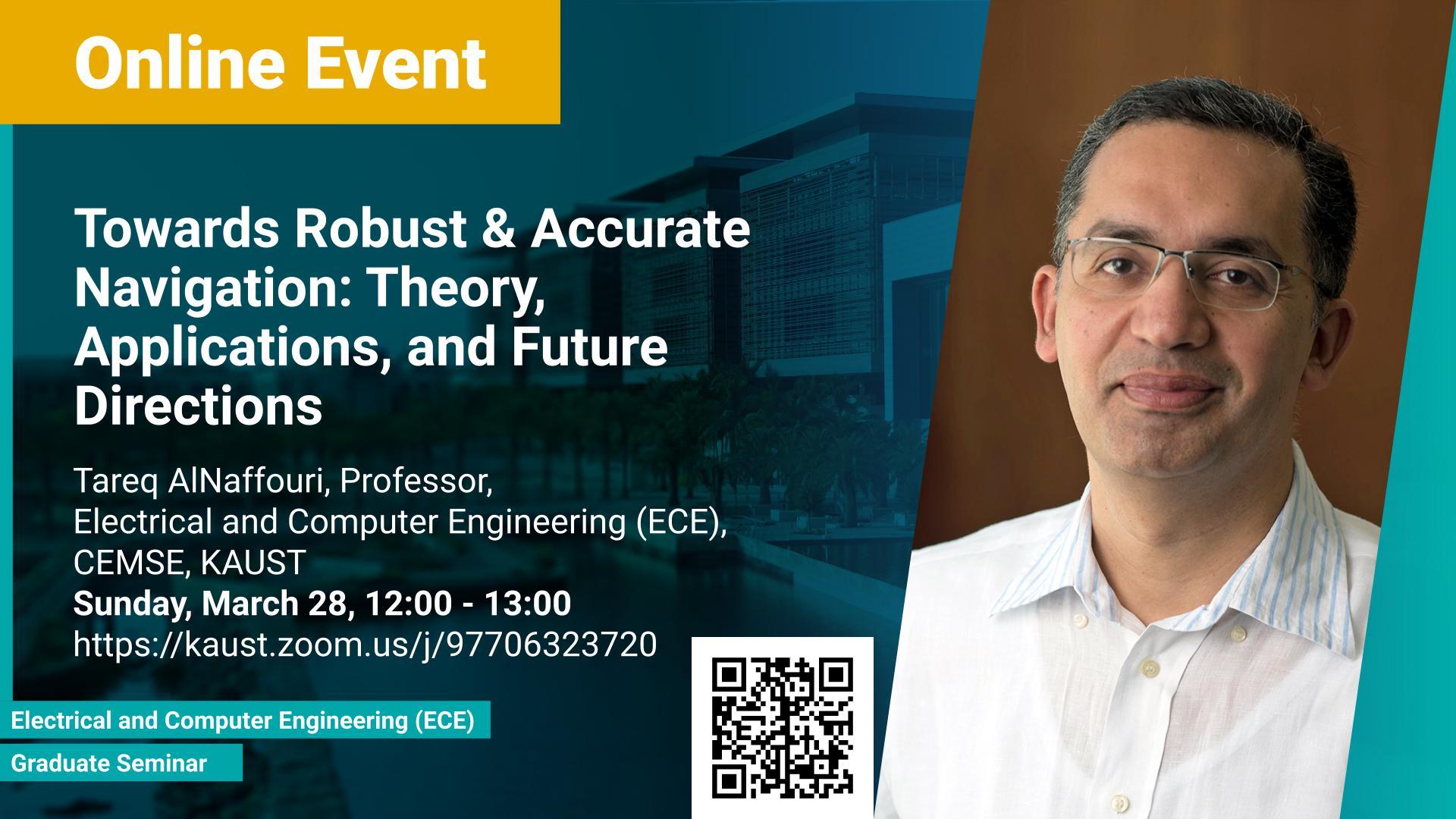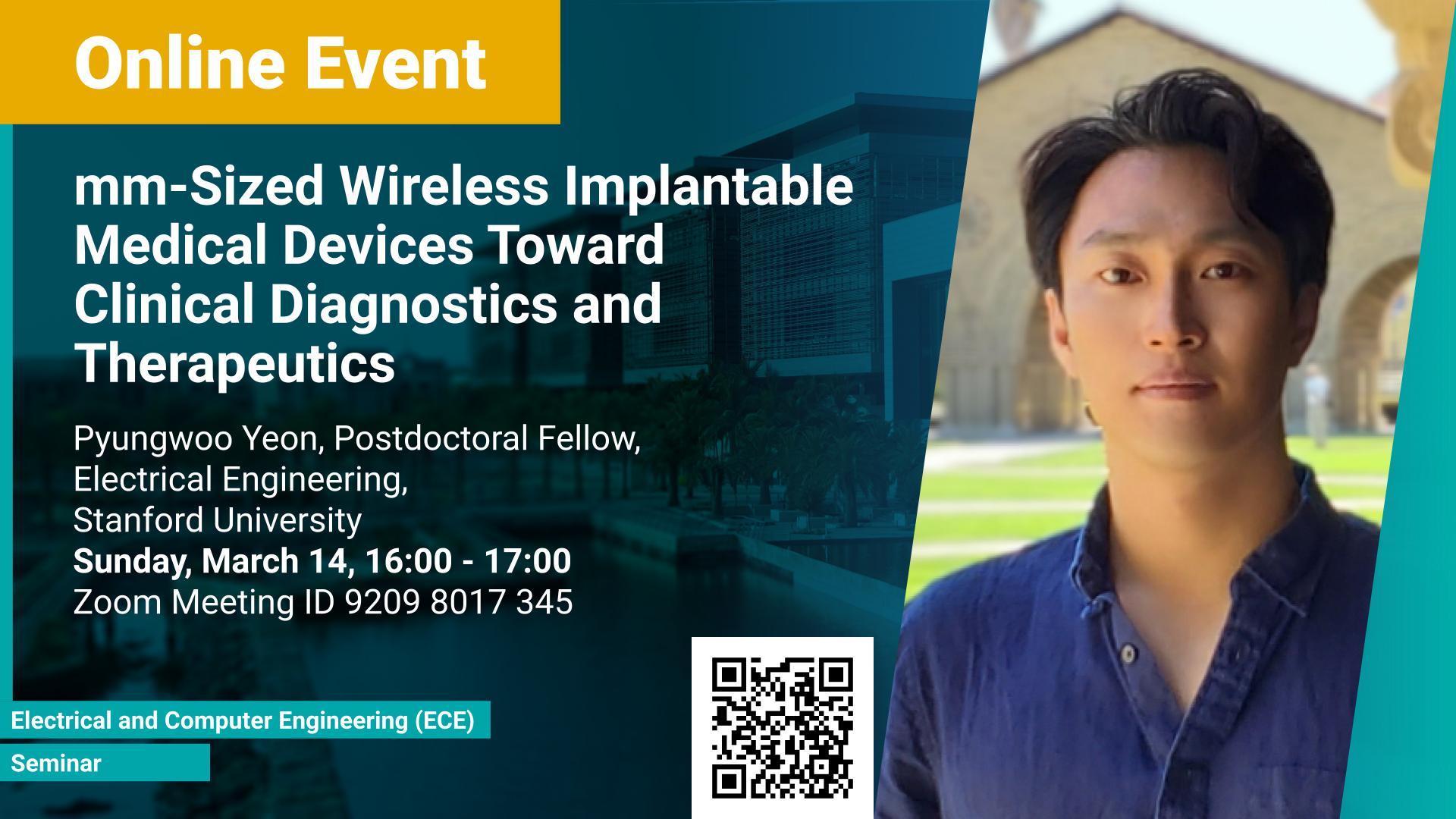Prof. Mamadou Diagne, Rensselaer Polytechnic Institute
Wednesday, June 02, 2021, 15:00
- 16:30
KAUST
Contact Person
Prof. Mamadou Diagne, Rensselaer Polytechnic Institute
Tuesday, June 01, 2021, 17:00
- 18:30
KAUST
Contact Person
PDE Backstepping Boundary Control of Parabolic PDEs
Partial Differential Equations (PDEs) are often used to model various complex physical systems. Representative engineering applications such as heat exchangers, transmission lines, oil wells, road traffic, multiphase flow, melting phenomena, supply chains, collective dynamics, and even chemical processes governing the state of charge of Lithium-ion battery, extrusion, reactors to mention a few. This course will explore the boundary control of a class of parabolic PDE via the well-known backstepping method.
Prof. Mamadou Diagne, Rensselaer Polytechnic Institute
Tuesday, June 01, 2021, 15:00
- 16:30
KAUST
Contact Person
Partial Differential Equations (PDEs) are often used to model various complex physical systems. Representative engineering applications such as heat exchangers, transmission lines, oil wells, road traffic, multiphase flow, melting phenomena, supply chains, collective dynamics, and even chemical processes governing the state of charge of Lithium-ion battery, extrusion, reactors to mention a few. This course will explore the boundary control of a class of parabolic PDE via the well-known backstepping method.
PhD Student,
Electrical and Computer Engineering
Wednesday, May 26, 2021, 18:00
- 19:30
KAUST
Contact Person
Wavefront sensing is a fundamental problem in applied optics. Wavefront sensors that work in a deterministic manner are of particular interest. Initialized with a unified theory for classical wavefront sensors, this dissertation discusses relevant properties of wavefront sensor designs. Based on which, a new wavefront sensor, termed Coded Wavefront Sensor, is proposed to leverage the advantages of the analysis, especially the lateral wavefront resolution. A prototype was built to demonstrate this new wavefront sensor.
H. Vincent Poor, Michael Henry Strater University Professor, Princeton University
Tuesday, May 25, 2021, 15:30
- 16:30
KAUST
Fifth generation (5G) wireless communication networks are being deployed worldwide and more capabilities are in the process of being standardized, such as massive connectivity, ultra-reliability, and low latency. However, 5G will not meet all requirements of the future, and sixth generation (6G) wireless networks are expected to provide global coverage, enhanced spectral/energy/cost efficiency, greater intelligence and security, etc. To meet these requirements, 6G networks will rely on new enabling technologies, i.e., air interface and transmission technologies and novel network architectures, such as waveform design, multiple access, channel coding schemes, multi-antenna technologies, network slicing, cell-free architecture, and cloud/fog/edge computing. One vision on 6G is that it will have four new paradigm shifts. First, to satisfy the requirement of global coverage, 6G will not be limited to terrestrial communication networks, which will need to be complemented with non-terrestrial networks such as satellite and unmanned aerial vehicle (UAV) communication networks, thus achieving a space-air-ground-sea integrated communication networks. Multiple spectra will be exploited to further increase data rates and connection density, including the sub-6 GHz, millimeter wave (mmWave), terahertz (THz), and optical frequency bands. Third, facing the very large datasets generated by heterogeneous networks, diverse communication scenarios, large numbers of antennas, wide bandwidths, and new service requirements, 6G networks will enable a new range of smart applications with the aid of AI-related technologies. And, fourth, network security will have to be strengthened when developing 6G networks. This talk will review recent advances and future trends in these four aspects.
Advances in Microelectromechanical Digital Circuit Design: Low Power Computation, Sensing and Beyond
Adjunct Professor,
Electrical and Computer Engineering
Sunday, May 02, 2021, 12:00
- 13:00
KAUST
Contact Person
Electromechanical switches were the core elements of the very first digital computers in early 20th century. While these switches were later replaced by the smaller, faster and more reliable "transistor" technology, they found a new life following the development of nanofabrication tools and Micro-electromechannical Systems (MEMS). In this seminar we will explore the most recent advances in the field of MEMS-based digital circuit and sensor design. We also examine the application of MEMS switches and resonators in building the most important blocks of a digital system, namely adders, multipliers, data converters, sequential and combinational complex logic, and discuss the future of this technology in the beyond-CMOS era.
Prof. Denis Dochain, ICTEAM, Université Catholique de Louvain
Tuesday, April 27, 2021, 14:00
- 15:30
KAUST
Contact Person
There are three main classes of wastewater treatment processes (WWTP’s): activated sludge, anaerobic digestion, and lagoon. The course will start to give a short introduction on these three types of WWTP’s. Each topic considered in the course will be illustrated via these three processes.
Prof. Denis Dochain, ICTEAM, Université Catholique de Louvain
Tuesday, April 27, 2021, 10:30
- 12:00
KAUST
Contact Person
There are three main classes of wastewater treatment processes (WWTP’s): activated sludge, anaerobic digestion, and lagoon. The course will start to give a short introduction on these three types of WWTP’s. Each topic considered in the course will be illustrated via these three processes.
Sunday, April 25, 2021, 12:00
- 13:00
KAUST
Contact Person
We review our recent results on artificial-intelligent designed ultra-flat materials that embeds "physical" neural networks for different application in biomedical imaging, optics, displays, and structural color generation.
Prof. Mohamed Djemai, University Polytechnique Hauts-de-France
Thursday, April 22, 2021, 14:00
- 15:30
KAUST
Contact Person
This research is motivated not only because the control of some systems is implemented through the combination of continuous control laws with discrete switching logic but also because a wide range of physical and engineering systems exhibit hybrid behavior. Among the problems to be addressed, those of stabilization and observation are particularly important in order to always improve the efficiency of systems in terms of performance, lifetime and efficiency.
Prof. Mohamed Djemai, University Polytechnique Hauts-de-France
Thursday, April 22, 2021, 10:30
- 12:00
KAUST
Contact Person
In recent years, new theoretical tools have been developed to describe complex systems more precisely, such as hybrid dynamical systems (HDS). Many works ranging from modelling to stabilisation, or control and observation have focused on the study of this class of systems. This research is motivated not only because the control of some systems is implemented through the combination of continuous control laws with discrete switching logic but also because a wide range of physical and engineering systems exhibit hybrid behavior. Among the problems to be addressed, those of stabilization and observation are particularly important in order to always improve the efficiency of systems in terms of performance, lifetime and efficiency.
Prof. Denis Dochain, ICTEAM, Université Catholique de Louvain
Tuesday, April 20, 2021, 14:00
- 15:30
KAUST
Contact Person
There are three main classes of wastewater treatment processes (WWTP’s): activated sludge, anaerobic digestion, and lagoon. The course will start to give a short introduction on these three types of WWTP’s. Each topic considered in the course will be illustrated via these three processes.
Prof. Denis Dochain, ICTEAM, Université Catholique de Louvain
Tuesday, April 20, 2021, 10:30
- 12:00
KAUST
Contact Person
The objective of this course is to give an introduction and cover recent aspects of dynamical modeling, monitoring and control of wastewater treatment processes. There are three main classes of wastewater treatment processes (WWTP’s): activated sludge, anaerobic digestion, and lagoon. The course will start to give a short introduction on these three types of WWTP’s. Each topic considered in the course will be illustrated via these three processes.
Assistant Professor,
Electrical and Computer Engineering
Sunday, April 18, 2021, 12:00
- 13:00
KAUST
Contact Person
The large population game framework has been widely adopted in biology, economics, and engineering fields to model and analyze strategic interactions among decision-making agents. In this framework, a population of agents select strategies of interaction with one another and repeatedly revise their strategy choices using revisions defined by a decision-making model. While many of existing works in the literature focus on designing decision-making models that ensure convergence of the agents’ strategy revision to Nash equilibrium, a still open challenge is to establish the convergence when the agents’ strategy revision is subject to time delay. Such scenarios include multi-agent decision problems in which there is delay in propagation of traffic congestion in congestion games, communication between the electric power utility and demand response agents in demand response games, and information transmission between agents in network games. In this seminar, I’ll introduce our recent work on designing a new decision-making model called the Kullback-Leibler (KL) divergence regularized learning. We will discuss how the new model enables a large population of agents to learn and self-organize to an effective strategy profile in population games subject to time delay and implication of the new model in engineering applications.
Prof. Mohamed Djemai, University Polytechnique Hauts-de-France
Thursday, April 15, 2021, 14:00
- 15:30
KAUST
Contact Person
This research is motivated not only because the control of some systems is implemented through the combination of continuous control laws with discrete switching logic but also because a wide range of physical and engineering systems exhibit hybrid behavior. Among the problems to be addressed, those of stabilization and observation are particularly important in order to always improve the efficiency of systems in terms of performance, lifetime and efficiency.
Prof. Mohamed Djemai, University Polytechnique Hauts-de-France
Thursday, April 15, 2021, 10:30
- 12:00
KAUST
Contact Person
In recent years, new theoretical tools have been developed to describe complex systems more precisely, such as hybrid dynamical systems (HDS). Many works ranging from modelling to stabilisation, or control and observation have focused on the study of this class of systems.
Ibrahima N’Doye, Research Scientist, Electrical and Computer Engineering (ECE), CEMSE, KAUST
Sunday, April 11, 2021, 12:00
- 13:00
KAUST
Contact Person
In this talk, I will present our recent works on reducing the beam pointing error for improved free-space optical communication (FSO) link performance. Specifically, I will discuss a robust control strategy that reduces the beam alignment error under controlled weak turbulence conditions for FSO systems. Then, I will discuss localization and tracking control of a mobile target ship with an autonomous underwater vehicle (AUV) in underwater environment. The framework is designed using a hybrid acoustic-optical underwater communication to drive the AUV to the maximum achievable data rate angle. The acoustic link is used for non-line-of-sight localization, and the optical link is for line-of-sight transmission. I will conclude the talk by providing recent results on estimating the alignment angle through a novel estimation-based reference trajectory control algorithm for an LED-based optical communication model.
PhD Degree,
Electrical and Computer Engineering
Thursday, April 08, 2021, 11:00
- 13:00
KAUST
Contact Person
Machine learning is emerging as a powerful tool to data science and is being applied in almost all subjects. In many applications, the number of features is comparable or even larger than the number of samples, and both grow large. This setting is usually named the high-dimensional regime. In this regime, new challenges and questions arise when it comes to the application of machine learning. In this work, we conduct a high-dimensional performance analysis of some popular classification and regression techniques. In a first part, discriminant analysis classifiers are considered. A major challenge towards the use of these classifiers in practice is that they depend on the inverse of covariance matrices that need to be estimated from training data. Several estimators for the inverse of the covariance matrices can be used. The most common ones are estimators based on the regularization approach. The main advantage of such estimators is their resilience to the sampling noise, making them suitable to high-dimensional settings. In this thesis, we propose new estimators that are shown to yield better performance.
Sunday, April 04, 2021, 12:00
- 13:00
KAUST
Contact Person
Energy is an indispensable part of our lives. We are challenging energy-saving novel light emitters and clean-energy generation systems at Energy Conversion Devices and Materials (ECO Devices) Laboratory at KAUST. The former is based on MOCVD technology, material science, and device technology. The latter is the nitride photocatalyst invented by Ohkawa. The development of highly-efficient InGaN-based blue LEDs was the topic of the 2014 Nobel Prize in Physics. InGaN-based green LEDs were realized after improving the quality of higher-In-content InGaN. The three primary colors in light are RGB. The current red LEDs are based on InGaP as the active region. If we realize red LEDs by InGaN, we can fabricate the monolithic RGB LEDs in a wafer. Such RGB integration will be a breakthrough for micro-LED displays that are the next generation after the OLED displays. In this seminar, the science of MOCVD, the growth of high-In-content InGaN, and the state-of-the-art InGaN-based red LEDs will be introduced.
Abdullah Almansouri, PhD Student, Electrical and Computer Engineering, KAUST
Thursday, April 01, 2021, 16:00
- 17:00
KAUST
Contact Person
The next technological revolution, Industry 4.0, is envisioned as a digitally connected ecosystem where machines and gadgets are driven by artificial intelligence. By 2025, more than 75 billion devices are projected to serve this revolution. Many of which are to be integrated into the fabrics of everyday life in the form of smart wireless sensors. Still, two major challenges should be addressed to realize truly wireless and wearable sensors. First, the sensors should be flexible and stretchable, allowing for comfortable wearing. Second, the electronics should scavenge the energy it requires entirely from the environment, thus, eliminating the need for batteries, which are bulky, create ecological problems, etc. By addressing these two challenges, this dissertation paves the way for truly wearable sensors.
Rui Chen, PhD Student, Electrical and Computer Engineering, KAUST
Wednesday, March 31, 2021, 16:00
- 18:00
KAUST
Contact Person
Time-domain methods are preferred over their frequency-domain counterparts for solving acoustic and electromagnetic scattering problems since they can produce wide-band data from a single simulation. Among the time-domain methods, time-domain surface integral equation solvers have recently found widespread use because they offer several benefits over differential equation solvers. This dissertation develops several second-kind surface integral equation solvers for analyzing transient acoustic scattering from rigid and penetrable objects and transient electromagnetic scattering from perfect electrically conducting and dielectric objects. For acoustically rigid, perfect electrically conducting, and dielectric scatterers, fully explicit marching-on-in-time schemes are developed for solving time domain Kirchhoff, magnetic field, and scalar potential integral equations, respectively.
Sunday, March 28, 2021, 12:00
- 13:00
KAUST
Contact Person
Navigation is an essential requirement for many applications (commercial, retail, military, scientific, ...etc) and in a variety of environments (in-doors, outdoors, space, underwater, and even underground). In this talk, I will overview some of my group's work in localization and navigation focusing on indoor and satellite positioning. The talk will demonstrate how the structure or constraints of the problem can help achieve very accurate localization (e.g. millimeter level indoors) that is robust to Doppler, multipath, and shadowing. The talk will also touch upon various related applications that the group is pursuing in smart health and smart cities. The talk will end with future directions for localization in extreme environments and in the TeraHertz spectrum where localization, environment sensing, and communication converge.
Hengshuang Zhao, Postdoctoral Fellow, Oxford University
Sunday, March 21, 2021, 12:00
- 13:00
KAUST
Contact Person
Building intelligent visual systems is essential for the next generation of artificial intelligence systems. It is a fundamental tool for many disciplines and beneficial to various potential applications such as autonomous driving, robotics, surveillance, augmented reality, to name a few. An accurate and efficient intelligent visual system has a deep understanding of the scene, objects, and humans. It can automatically understand the surrounding scenes. In general, 2D images and 3D point clouds are the two most common data representations in our daily life. Designing powerful image understanding and point cloud processing systems are two pillars of visual intelligence, enabling the artificial intelligence systems to understand and interact with the current status of the environment automatically. In this talk, I will first present our efforts in designing modern neural systems for 2D image understanding, including high-accuracy and high-efficiency semantic parsing structures, and unified panoptic parsing architecture. Then, we go one step further to design neural systems for processing complex 3D scenes, including semantic-level and instance-level understanding. Further, we show our latest works for unified 2D-3D reasoning frameworks, which are fully based on self-attention mechanisms. In the end, the challenges, up-to-date progress, and promising future directions for building advanced intelligent visual systems will be discussed.
Pyungwoo Yeon, Postdoctoral Fellow, Electrical Engineering, Stanford University
Sunday, March 14, 2021, 16:00
- 17:00
KAUST
Contact Person
Implantable and wearable technologies are rapidly emerging and showing great promise in various medical therapeutics and diagnostics. These advances from health monitoring to therapeutic applications reorganize many aspects of daily life. Since the invention of the first implantable cardiac pacemaker for patients with arrhythmia in 1958, many implantable medical devices (IMDs) such as implantable cardioverter defibrillators (ICDs) and implantable deep brain stimulators (iDBSs) have been developed and have treated millions of patients. These IMDs eventually need wireless powering and communication for 1) eliminating transcutaneous power/data interconnects that elevate the risk of infection and 2) removing bulky batteries to avoid the risk of repeated surgical intervention. They also need small form factors and soft materials to mitigate tissue fibrosis due to foreign body responses. In this talk, I will introduce a new wireless neural interfacing tool within a cubic millimeter that can potentially record large scale neuronal ensembles over large brain area. The discussion will be focused on its building pieces across a wide range of science and engineering disciplines toward translating those into a complete clinically viable IMD. Also, I will present my recent research on RF-to-ultrasound power relay for powering deep mm-scale implants across air/tissue or tissue/skull media, and an all-soft and wireless pressure sensor tags that aim to address the issues of surgical complexity, tethering effect, and foreign body response. Finally, I will conclude the talk by presenting my future research plans toward clinically viable wireless medical diagnostics and therapeutics.
PhD Student,
Electrical and Computer Engineering
Wednesday, March 10, 2021, 12:00
- 14:00
KAUST
Contact Person
The objective of this work is to develop a near-infrared laser device capable of emitting orbital angular momentum (OAM) light. The prototyped device must be suitable for compact, energy-saving optical communication applications. Integrated OAM lasers would revolutionize high capacity data transmission over any telecommunication network environment as OAM light can be guided and transmitted through kilometers of optical fibers as well as propagated in free space and underwater.
